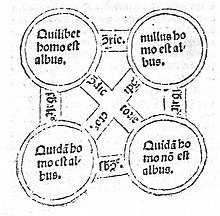
Back የተቃርኖ አራት ማዕዘን Amharic Quadre d'oposició dels judicis Catalan چوارگۆشەی بەرامبەری CKB Das logische Quadrat German Τετράγωνο Αντίθεσης Greek Cuadro de oposición de los juicios Spanish Carré logique French विरोध वर्ग Hindi Տրամաբանական քառակուսի Armenian Quadrato delle opposizioni Italian
This article needs additional citations for verification. (February 2015) |


In term logic (a branch of philosophical logic), the square of opposition is a diagram representing the relations between the four basic categorical propositions. The origin of the square can be traced back to Aristotle's tractate On Interpretation and its distinction between two oppositions: contradiction and contrariety. However, Aristotle did not draw any diagram; this was done several centuries later by Apuleius and Boethius.